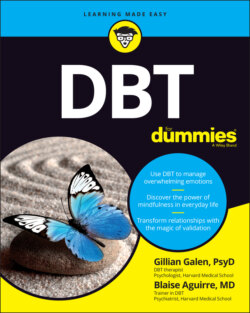Читать книгу DBT For Dummies - Gillian Galen - Страница 69
Widening your range of emotions
ОглавлениеIt’s in our nature as human beings to feel emotions. For people who are emotionally sensitive, emotions are the very experiences that make them suffer, and often all they want to do is to get rid of their emotions. Because they want to get rid of their emotions, the last thing they want to do is to examine them deeply, but that is the very thing that DBT requests of people.
If you’re emotionally sensitive, it’s possible that you feel a huge range of different feelings in response to situations. So, for instance, if you’re depressed, you may feel sad, but this sadness will often come with feeling lonely, misunderstood, hopeless, and so on. The reason why it is hard to identify exactly how you’re feeling is that the emotions seem to come on really quickly and they are then blended with other feelings as well as thoughts. As a result, the experience can be confusing.
To deal with what is actually going on and to address the main emotion being experienced, DBT gets patients to recognize the emotional experiences that occur most often and to separate out primary emotions and secondary emotions. In so doing, you’re more likely to describe how you are truly feeling:
Primary emotions: A primary emotion is the first emotion experienced, which is connected directly to the event that generated the emotion. The emotion is typically short in duration; however, as time passes and we get away from the event that caused it, the primary emotion rapidly dissipates and starts to take on other elements, such as thoughts or other emotions. Primary emotions are like a snowball that begins to slide down a steep mountain. Without slowing down, the primary emotion can gather steam and become an avalanche of secondary emotions that can be more overwhelming and harder to stop. It rarely stops and just stays as the snowball, and it is in the gathering of more snow and other things like rocks that it can become an avalanche. Primary emotions are less complicated and easier to understand. From a DBT perspective, there are ten primary emotions, and we review these further in Chapter 10.
Secondary emotions: Secondary emotions are essentially emotional reactions to primary emotions. These are learned emotional reactions that we typically develop as a result of the experiences of early childhood and observing our parents and their reactions. There is a wonderful explanation of secondary emotions from the movie Star Wars: The Phantom Menace, when Master Yoda says, “Fear leads to anger, anger leads to hate, hate leads to suffering.” A way to know whether an emotion is primary or secondary is that if the emotion lingers long after an event has happened, it’s likely to be secondary. If the emotion is complex and hard to define or identify, it’s almost always secondary.
And so the new perspective is this: By paying attention to emotions rather than avoiding them, you not only widen your range of experience, but you also recognize that although they may be painful, they won’t destroy you. In recognizing this fact, you can develop the skills needed to manage intense emotions.
